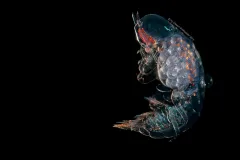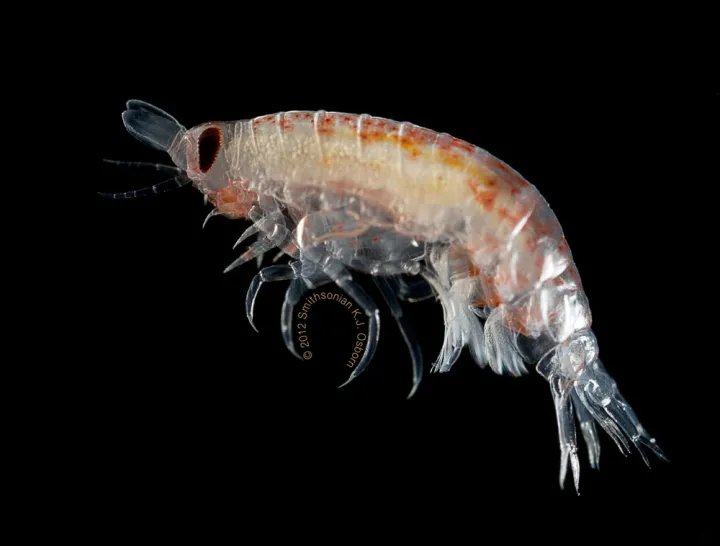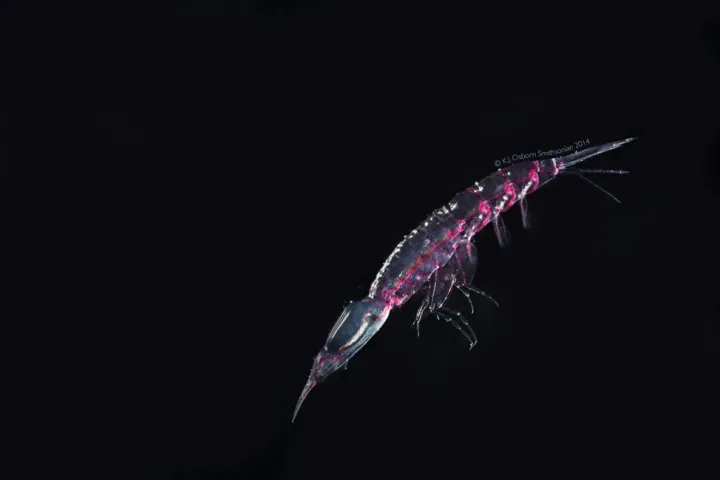Many Eyes, Many Perspectives: The Astonishing Visual Systems of Hyperiids

In any given scoop of seawater, you will find an assortment of tiny critters called plankton. Amidst the plankton you might find some wild-eyed crustaceans called hyperiid amphipods. Up to 11 different types of eyes have been discovered within the 350 species of hyperiids, and many of them are totally unique. Some species have two pairs of eyes, each looking in a different direction. Others have cylindrical eyes with 360-degree vision, and yet others have no eyes at all. Of the 10,000 amphipod species, hyperiids are the only major group with such remarkable eyes. The rest have small variations on the sameーrelatively simple, flat compound eyes. So, the question of why hyperiids would evolve such amazing eyes while the rest of amphipods keep it simple is one that intrigues scientists.
Hyperiids are the only amphipod group to be found exclusively in the midwaterーthe deep, open ocean between the surface and the seafloor. The habitat lacks physical landmarks and provides limited light, food, and sometimes oxygen to its residents. In these conditions, energy is a precious resource. Eyes require a lot of energy to build, but for hyperiids, it’s a worthwhile investment.
Hyperiids’ visual adaptations seem to be a response to the pressure of needing to see without being seen. To avoid being seen, hyperiids camouflage their bodies through transparency or by using chromatophores that allow them to mask parts of their bodies. Eyes, though, are hard to hide because of their need for pigment. Human eyes, for example, have different pigments to block out, control, and absorb light. But if you put something as noticeable as a human eye in the midwater, it would be gobbled up immediately. To stay hidden, many midwater predators have evolved ways to find prey without sight, like heightened tactile senses which allow them to feel movement in the water. To keep their eyes, several hyperiids have stripped them of all pigments except the essential absorbing pigments, making them as close to transparent as possible. They’ve found many ways to do this depending on what type of lifestyle they have or the type of prey they hunt, hence the variability in eye types. These adaptations grant hyperiids sight, an invaluable advantage over their competitors, without being made a traveling lure.
Nature rarely breeds this level of visual strangeness and variability in such a (relatively) small group of species. These weird animals have fascinated Smithsonian curator, Karen Osborn, ever since she began her tenure at the National Museum of Natural History. “They’re a typical midwater group,” Osborn says of hyperiids, “we know a little bit, but we don’t really know anything about them.” Osborn is all too familiar with this problem, as her research program focuses on how animals have adapted to life in the midwater. With hyperiids, Osborn is characterizing the great diversity of their eyes, figuring out the advantages of the different eye designs, and relating that information to what she is learning about how they live.
This is a big task, and so Osborn has recruited several other researchers to work on the different aspects of the project. In the early days of the project, Jamie Baldwin Fergus joined the project as a postdoctoral researcher, who characterized the eyes of the Paraphronima gracilis, which take up almost half of the animal’s body and are mostly transparent except for their vividly orange retinas. Her work was featured in a popular exhibit on deep sea diversity and paved the way for the future of hyperiid research in Osborn’s lab.
Recently, the addition of another postdoc, Chan Lin, allowed the project to venture beyond the eyes themselves into the parts of the brain that process visual information. Lin’s work focuses on the brain anatomy of arthropods (a group that includes insects and crustaceans). He has discovered that, like their eyes, hyperiid brains are also highly variable. “Eyes evidently can be relatively plastic,” Osborn explains, “but not many groups have changed to the point that their brains follow suit.” Considering that brains are also energetically expensive body parts, these changes are likely also driven by the midwater environment.
While Lin examined hyperiid brains, others in Osborn’s lab made strides technologically. Ali Kazerani, a recent intern with a background in electrical engineering and programming, joined to process 3D structural information from microCT scans of hyperiid heads. However, the process fully frustrated him after just one day, so he proposed another approach. Kazerani began writing code to automate the processing of that data. When fully developed, Kazerani’s computer code will condense many months’ worth of work into only a couple of days. These efforts made possible a new collaboration with Jan Hemmi at the University of Western Australia, who developed a program that documents the wide variety of compound eyes from 3D data. Hemmi’s program accomplishes the dramatic reduction in time required to analyze additional features of the eyes and allows the team to model exactly what the animals see and how they see it, which helps us understand how the many different hyperiids are using their many different eyes.
This work goes beyond just hyperiids. With some refinement, both sets of code will become part of a software package that can be used to analyze compound eyes throughout the animal kingdom. What is learned from studying a wide variety of eye designs could lead to advancements in cameras and other optical technologies. Lin also hopes to see their work applied to medicine, as studying the functionality of hyperiid eyes in the low-oxygen parts of the midwater could inspire solutions to eye diseases associated with lack of oxygen, such as eye strokes.



